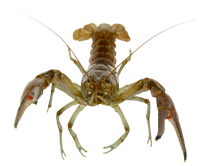Behavioral Neuroscience, lecture on Crayfish Medial Giant gating
Escape - Crayfish
VII. Gating Medial Giant Circuits
A. Sensory Interneurons (SI) have electrical synapses with MG neurons
1. electrical synapses directly transfer action potential
a. via gap junctions
i. connexons allow direct cytoplasmic contact
2. MG neurons have electrical synapses with MoG neurons
a. MoG = motor Giants
i. motor neurons activating muscle
b. latency of only a few milliseconds
3. trigger all abdominal segments from only rostral sensory stimulation
a. suggests that MGs control the entire behavior
b. referred to as "Command Neurons"
B. Command Neurons - an early concept
1. envisioned as a neural 'decision making' cell
a. trigger a complete behavioral act
2. receive convergent sensory and integrative input
a. output to 'pattern-generating circuits'
b. \ linked to another early concept:
the Central Pattern Generator (CPG)
3. 'Stereotypic' response patterns
a. also linked to the ethological idea of the 'Fixed Action Pattern'
i. behavioral module with a high degree of temporal
and spatial constancey
(1) stereotypy
b. e.g. MG firing produces complete, stereotypical tail flip escape
i. in fish: Mauthner firing correlates with electromyographic (EMG)
output of trunk musculature in escape behavior
4. implied that the CNS contained arrays of command cells and CPGs
a. dedicated to triggering fixed action patterns
b. behavior from hierarchical serial sequence of neural signals
c. decision to execute = firing of command cell
d. each command cell should be 'necessary' and 'sufficient'
for triggering the behavior
i. necessary - blocking cell firing prevents behavior, always
ii. sufficient - artificial activation of the command cell
should result in complete expression of the behavior
(1) proposed by Kupfermann and Weiss in 1978
5. contrasts with distibuted circuit connected in parallel to output ciricuit
a. pattern of activity in group of cells trigger behavior
b. no single cell unambiguously triggers output
i. parallel MG, LG, NG circuits
all capable of triggering tail flip response
6. MG, LG, and even NG cells stimulate a rapid stereotypic response
a. MG and LG cells could be “command neuron” prototypes
b. if they are parallel circutis are they command neurons?
C. Parallel Networks in Fish Escape
1. Mauthner cell (M) ablations do not abolish C-Start Escape in fish
a. Delay its onset by a few ms
b. but M cell activation alone can trigger stage 1
i. resulting behavior is less variable than normal behavior
ii. like MG cells
2. C-start almost never occurs without firing the Mauthner cell
a. Mauthner neuron always fires first (like MG)
i. before all other brainstem neurons
3. \ Mauthner cells are “command-like” neurons
participating in a parallel “brainstem escape network”
4. Parallel escape network finely regulates the escape trajectory
a. made up of M cell homologs
i. MiD2cm and MiD3cm
ii. other descending reticulospinal neurons
b. Mauthner homologs can fire bursts of action potentials
i. Mauthner cells only fire 1 AP
1) like MG cells
c. Mauthner homologs also activate spinal circuits
i. cause the trunk musculature to contract
1) like NG cells
ii. contribute to the normal behavior
iii. activated with a longer latency by sensory inputs
iv. higher firing threshold than the Mauthner cell
v. \ longer delay
when compensating for the absence of Mauthner cells
D. Crayfish circuitry has 3 parallel circuits
1. and 2 or more distintive behaviors
2. MG neurons can directly activate MoGs
3. MGs also activate Segmental Giant neurons (SG)
a. electrical synapses
b. SG interneurons innervate fast flexor (FF) motor neurons
i. another redundant system
4. MGs activate all abdominal segment motor systems
a. Why are LG and NG systems necessary?
